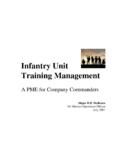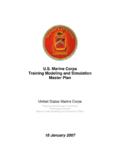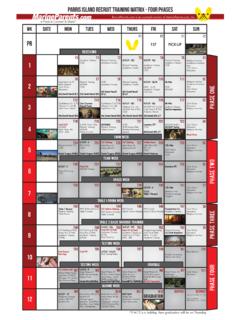Transcription of UNITED STATES AIR FORCE - Defense Technical …
1 T 1 I L . UNITED STATES AIR FORCEO4cLnmMILITARY training INSTRUCTOROCCUPATIONAL ANALYSIS PROGRAMUSAF occupational MEASUREMENT CENTERAIR training COMMANDRANDOLPH AFB, TEXAS 78150-5000 OCCUPATONLESE; DISTRIBUTION P NRIITEUSAFOCCPATINALMEASREMNT CNTEDISTRIBUTION FORSDI 99502 OSR AND SUPPORTING DOCUMENTSANL TNG JOBOSR EXT EXT INVAFMPC/DPMRPQ1 2 AFMPC/DPMRAD4 1 ARMY occupational SURVEY BRANCH 1 CCAF/AYX 1 Defense Technical INFORMATION CENTER 2 DET 1, USAFOMC (LACKLAND AFB TX) I 1 1 HRL/MODS 2 im Im IHRL/ID 1 1m lm/lh 1HQ AFISC/DAP 2HQ AFMTC/BMTS 1HQ ATC/TTS 2 1HQ BMTS/MTT 6 6 6 6HQ USAF/DPPE 1 NODAC 1 USAF Preparatory School 3 3 USAFA/CWDC 5 5 USAFA/DOP 3 3 USAFA/DPRR 1 1 USMC (CODE TE-310) 13250 TCHTW/TTS (LACKLAND AFB TX) 1 13507 ACS/DPKI 1 USAFOMC/OMDQ 1 USAFOMC/OMYXL 10 2m 2m/5h 10m = microfiche onlyh = hard copy onlyAccesion ForNTIS CRALIDTIC TAB 0 Unannounced 0 JusIti Cdtio(nByDistributionAva1ddbilhty CodesDist Sec nITABLE OF CONTENTSPAGENUMBERPREFACE.)
2 IiiSUMMARY OF RESULTS ..ivINTRODUCTION ..1 Background ..1 SURVEY METHODOLOGY..2 Inventory Development..2 Survey Administration..3 Survey Sample ..Task Factor Administration ..6 Data Processing and Analysis ..6 SPECIALTY JOBS (Structure of Work)..7 Structure Overview..7 Descriptions of SDI 99502 Jobs..9 Comparison of Specialty Jobs ..16 Job Structure Comparison to Previous Survey..17 ANALYSIS OF AFR 39-1 SPECIALTY DESCRIPTION..17 training ANALYSTS..19 training Emphasis and Task Difficulty..19 Analysis of First-Assignment (1-36 Months TICF) Personnel ..20 Review of Plan of Instruction (POI) ..25 JOB SATISFACTION ANALYSIS ..27 ANALYSIS OF MAJOR COMMANDS (MAJCOM)..31 SPECIAL ISSUES..34 IMPLICATIONS..35 APPENDIX A..39 PREFACEThis report presents the results of an Air FORCE occupational survey ofthe Military training Instructor Special Duty Identifier (SDI) 99502.
3 Author-ity for conducting occupational surveys is contained in AFR 35-2. Computerproducts upon which this report is based 3re available for use by operationsand training su4vey instrument was developed by Mr Donald J. Cochran, inventoryDevelopment Specialist. Ms Rebecca R. Hernandez, Computer Programmer, pro-vided computer support for this project. Administrative support was providedby Mr Richard G. Ramos. Second Lieutenant Lisa A. Boyce analyzed the data andwrote the final report. This report has been reviewed and approved by Lieu-tenant Colonel Charles D. Gorman, Chief, Airman Analysis Branch, USAF Occupa-tional Measurement Military training Instructor training Requirements Analysis (TRA) isbeing accomplished in conjunction with the Military training Instructor TRA will provide a comprehensive data base to support anticipated trainingdecisions for the SDI.
4 It consists of three sections: a) System Overview--an overall perspective of the SDI training ; b) Task Analysis--detailed train-ing decision data for SDI Technical tasks; and c) training Requirements/Recommendations--what should be trained, when training should occur, and wheretraining should be of this report are distributed to Air Staff sections, Major Com-mands, and other interested training management personnel (see distribution onpage i). Additional copies are available upon request to the USAF Occupa-tional Measurement Center, Attention: Chief, occupational Analysis Division(OMY), Randolph AFB, Texas P. TINDELL, Colonel, USAF JOSEPH S. TARTELLC ommander Chief, occupational Analysis DivisionUSAF occupational Measureme,- USAF occupational MeasurementCenter CenterSUMMARY OF RESULTS1. Survey Coverage: Survey results are based on responses from 402 MilitaryTraining Instructors (SDI 99502).
5 This represents 64 percent of all assignedSDI 99502 airmen. Survey responses are substantially proportional to assign-ments by command and are therefore representative of jobs within this Structure of Work: Seven different job clusters and four independent jobtypes (IJT) are identified in the 99502 SDI. The largest job, Basic MilitaryTraining Squadron Instructors, involves the performance of flight instructorfunctions for nonprior service airmen. The other jobs include Military Drilland Ceremony NCOs, Military training Supervisors, Officer CommissioningInstructors, Parachute/Confidence Course NCOs, Military training AcademicInstructors, Military training Instructor School Instructors, CurriculumDevelopers, Supply/Physical Conditioning Instructors, Instructor Evaluators,and Scheduling/Plans NCOs. Each cluster is either directly involved with thetransitioning of civilians into military members by providing guidance throughdaily interaction or providing instruction in specialized areas of IJTs provide the support functions which enhance the efficiency of thistraining AFR 39-1 Specialty Descriptions: The description in AFR 39-1 for the99502 Military training Instructor SDI provides a broad overview of tasks andduties performed by each specialty job.
6 A few discrepancies are noted in thatthe document does not reference the military training provided for the officercandidates at the Officer training School (OTS). Functions such as curriculumdevelopment and physical conditioning are also not specifically personnel should review the current description for training Analysis: A review of the SDI 99502 Plan of Instruction (POI3 AIR99502) reveals most areas are supported by survey data. Specifically, alltasks matched to the POI performance-level objectives have greater than 30percent of first-assignment personnel performing, accounting for 67 coursehours. Several tasks with greater than 30 percent performance levels are notreferenced to the POI. training personnel should review this document forpossible inclusion of these tasks. Possible realignment of course hours mayalso be Job Satisfaction: Overall, Military training Instructors are generallysatisfied with their jobs.
7 Respondents from both the 1989 and 1979 surveysindicate similar high levels of satisfaction. Members in the specialty jobsalso appear very satisfied. One hundred percent of the members in 6 of the 11specialty jobs perceive their talents and training to be utilized "fairlywell," "excellently,"' or "perfectly."6. MAJCOM Analysis: Analysis identifies minor differences between do not involve the overall jobs performed by the two usingcommands. The distinctions noted between Air training Command (ATC) and USivAir FORCE Academy (USAFA) are primarily involved with background data, such asTotal Active Federal Military Service and Professional Military Education andtime spent performing Implications: The SDI 99502 is fairly homogeneous, with one specialtyjob, BMTS Instructors, representing 61 percent of the SDI. The AFR 39-1 jobdescription is generally adequate, but should be reviewed for possible inclu-sion of OTS instructors, course development, and physical conditioning func-tions.
8 In terms of the training document, the POI is generally wellsupported. However, a few high performance tasks are not referenced to POIobjectives and should be reviewed. Overall, job satisfaction is positive forthe jobs identified. All assignment groups also indicate high satisfactionlevels, similar to the previous OSR data published in 1979. Finally, MAJCOM analysis identifies only minor differences. Essentially, ATC and USAFA Mili-tary training Instructors are performing in similar jobs across the nmmmme li m~ i~ ' occupational SURVEY REPORTMILITARY training INSTRUCTOR SPECIAL DUTY IDENTIFIER(SOI 99502)INTRODUCTION this is a report of an occupational survey of personnel in the MilitaryTraining Instructor SDI completed by the occupational Analysis Division, USAFO ccupational Measurement Center, in April 1989. The last occupational surveyof this SDI was conducted in December 1979.
9 This survey was requested by theHeadquarters Basic Military training School Commander, Lackland AFB TX. Theprimary purpose of conducting the survey was to collect current data to assistin evaluating major changes experienced in the SDI 99502 since the last Military training Instructor School (MTIS) is awaiting updated informationconcerning these changes before initiating a review of their course curricu-lum. The survey data will also impact current JQS revision efforts. /s. ,'s --" ~ ~~~~~ IV-C ~~ ~ FAccording to the AFR 39-1 Specialty Description for SDI 99502, dated1 Feb 88, Military training Instructors (MTI) plan, organize, direct, andinstruct basic and initial military training for nonprior service airmen,including those of the Air Reserve Forces and cadets at the UNITED STATES AirForce Academy (USAFA). Additional MTI duties include inspecting and evaluat-ing military training activities, personnel, and facilities, as well as pre-paring and maintaining pertinent files and majority of SDI 99502 airmen are located in six organizations: BasicMilitary training Squadron (BMTS) Instructors, BMTS Staff, MTIS Instructors,Officer training School (OTS) MTIs, Air FORCE Academy MTIs, and Air ForceReserve (AFRES) MTIs.
10 BMTS Instructors, often referred to as "Street TrainingInstructors (TI)", receive and train new members entering the Air FORCE for a6-week period, approximately six times a year. Currently, there are eightBMTSs at Lackland AFB TX. BMTS Staff are the MTIs who perform in staff posi-tions, such as academics, curriculum development, standardization/evaluation,and plans and scheduling. These individuals are assigned to the BMTS Head-quarters (HQ). MTIS Instructors conduct courses for the MTI School atLackland AFB. OTS MTIs instruct and train students undergoing officer train-ing at Medina Base, Lackland Annex. Air FORCE Academy MTIs instruct and traincadets at the Air FORCE Academy and Preparatory School in initial military andparachute training . AFRES MTIs perform weekend duty as training instructorswithin the BMTS at Lackland duty is open to career airmen in grades E-4 thru E-9, both male andfemale, regardless of their primary AFSC.

















